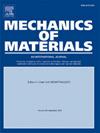通过界面性能图解读晶界成分-结构-力学性能关系
IF 4.1
3区 材料科学
Q2 MATERIALS SCIENCE, MULTIDISCIPLINARY
引用次数: 0
摘要
晶界是影响多晶材料许多力学性能和变形过程的平面晶体缺陷。了解GBs的界面结构及其与力学性能的关系是材料科学的中心课题。然而,表征GB结构及其性质往往需要高度复杂和耗时的实验过程,这使得理解GB组成-结构-性质关系成为一个巨大的挑战。以铜银(Cu-Ag)为模型系统,采用高通量原子模拟与机器学习技术相结合的方法,建立了四种不同对称性的GB性质图,揭示了GB成分、结构和力学性能之间的关系。界面图表明,无序和自由体积等局部结构特征对合金力学性能的影响较大,Ag偏析的影响较小。位错分析表明,非对称GBs表现出方向依赖的变形行为,其中层错优先向具有高折射率面的晶粒中发射,并伴有位错成核。本研究不仅扩展了现有的GB力学性能图族,使之包括各种GB类型,而且增强了我们对GB变形机理的基本认识。本文章由计算机程序翻译,如有差异,请以英文原文为准。

Deciphering grain-boundary composition-structure-mechanical property relationships via interfacial property diagrams
Grain boundaries (GBs) are planar crystal defects that significantly influence many mechanical properties and deformation processes of polycrystalline materials. Understanding the interfacial structures of GBs and their relationships to mechanical properties is a central topic in materials science. However, characterizing GB structures and their properties often requires highly sophisticated and time-consuming experimental procedures, making it a grand challenge in understanding the GB composition-structure-property relationships. Using copper-silver (Cu-Ag) as a modeling system, we adopted high-throughput atomistic simulations combined with machine learning techniques to uncover the relationships between GB compositions, structures, and mechanical properties by developing GB property diagrams for four types of GBs with different symmetry. These interfacial diagrams reveal that GB local structural features, such as disordering and free volume, plays more important roles in controlling the GB mechanical properties, while Ag segregation plays a minor role. Dislocation analysis shows that nonsymmetric GBs exhibit direction-dependent deformation behaviors, where stacking faults preferentially emitted into the grains with high-index planes accompanied by dislocation nucleation. This study not only expands the existing family of GB diagrams of mechanical properties to include various GB types, but also enhances our fundamental understanding of GB deformation mechanisms.
求助全文
通过发布文献求助,成功后即可免费获取论文全文。
去求助
来源期刊

Mechanics of Materials
工程技术-材料科学:综合
CiteScore
7.60
自引率
5.10%
发文量
243
审稿时长
46 days
期刊介绍:
Mechanics of Materials is a forum for original scientific research on the flow, fracture, and general constitutive behavior of geophysical, geotechnical and technological materials, with balanced coverage of advanced technological and natural materials, with balanced coverage of theoretical, experimental, and field investigations. Of special concern are macroscopic predictions based on microscopic models, identification of microscopic structures from limited overall macroscopic data, experimental and field results that lead to fundamental understanding of the behavior of materials, and coordinated experimental and analytical investigations that culminate in theories with predictive quality.
 求助内容:
求助内容: 应助结果提醒方式:
应助结果提醒方式:


